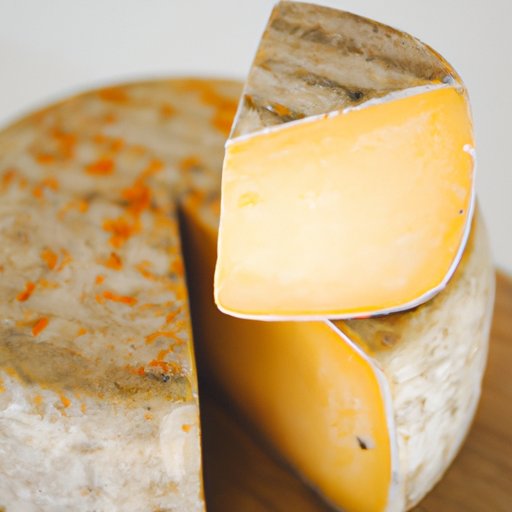
I. Introduction
If you are lactose intolerant, allergic to milk, or a vegan, you may be missing out on the simple pleasure of enjoying cheese. Fortunately, there’s a solution for cheese lovers with dietary restrictions: dairy-free cheese.
Dairy-free cheese refers to a type of cheese made without milk or other dairy products. It’s a flavorful and creamy alternative to traditional cheese, making it a popular choice for those with dietary restrictions or preferences.
II. Dairy-Free Cheese Substitutes
Dairy-free cheese usually contains plant-based ingredients such as soy, nuts, tofu, or coconut oil. These ingredients help replicate the texture and taste of cheese.
When it comes to alternative cheese options, soy, almond, and cashew-based cheeses are the most popular options. Soy-based cheeses are often lower in fat and calories, while nut-based cheeses are rich in healthy fats and vitamins. Tofu is often used as a base for soft cheeses, and coconut oil is ideal for making hard, meltable cheeses.
In terms of nutrition, plant-based cheese is generally lower in fat and calories than dairy cheese. However, it’s important to check labels for added sugars, sodium, and fillers.
III. Popularity and Production of Dairy-Free Cheese
The demand for dairy-free cheese has skyrocketed in recent years, with the global market for vegan cheese projected to reach $4.5 billion by 2024. More and more companies are embracing plant-based ingredients as a means of making animal-friendly, health-conscious, and environmentally sustainable products.
The production process for dairy-free cheese involves a variety of techniques, depending on the cheese alternative being used. For example, nuts must be soaked, washed, and blended to create nut-milk, which is then fermented to make a cheese-like consistency. Soy-based cheese requires soy milk, which is then curdled and pressed to form a block of cheese.
Many dairy-free cheese brands tout the sustainability benefits of plant-based cheese production, as it requires fewer resources than dairy farming. Dairy farming is known to be a resource-intensive process that can harm the environment through land conversion, water pollution, and greenhouse gas emissions.
IV. Making Dairy-Free Cheese at Home
Making dairy-free cheese at home is a fun and easy way to experiment with new flavors and textures.
To make your own dairy-free cheese, you’ll need a food processor or blender, a nut milk bag, and cheese molds. Popular ingredients for making dairy-free cheese at home include cashews, almonds, tofu, and coconut cream.
Basic dairy-free cheese can be made by blending soaked nuts or tofu with nutritional yeast, vinegar, and seasonings. The mixture is then molded and left to ferment for several hours.
For best results, it’s important to follow a recipe and experiment with different ingredients and flavorings until you find what works for you.
V. Best Tasting Dairy-Free Cheese Brands
Choosing the right dairy-free cheese brand can be a challenge, as there are many options available. Some popular dairy-free cheese brands include Daiya, Follow Your Heart, Miyoko’s Kitchen, and Violife.
When choosing a dairy-free cheese brand, it’s important to consider texture, taste, and meltability. Some vegan cheeses are designed for melting while others work better in salads or sandwiches. It’s also important to read labels carefully, as some dairy-free cheeses contain fillers and additives.
Homemade dairy-free cheese can also be an option, as it allows you to customize the flavor and texture to your liking. However, making homemade cheese can be time-consuming and requires a bit of skill.
VI. Creative Recipes Using Dairy-Free Cheese Alternatives
Dairy-free cheese can be used in a variety of recipes, including pizza, lasagna, and mac and cheese. It can also be used to make cheesy dips, spreads, and dressings.
When substituting dairy-free cheese in recipes, look for cheeses that are designed to melt and have a similar taste profile to traditional cheese. Some cheeses work better in specific recipes than others, so it may require some experimentation to find the right option.
Unique ideas for using dairy-free cheese in recipes include using it as a stuffing for vegetables, making grilled cheese sandwiches, or adding it to a cheese board for entertaining.
VII. Pros and Cons of Going Dairy-Free
While dairy-free cheese offers a delicious alternative for those with dietary restrictions or preferences, going dairy-free can have additional benefits.
Some people experience digestive distress when consuming dairy, while others may be lactose intolerant or allergic. Going dairy-free can help alleviate these symptoms and improve overall gut health.
Eliminating dairy from your diet can also improve skin health, reduce inflammation, and lead to weight loss. However, it’s important to make sure you’re getting enough calcium and other nutrients that are typically found in dairy products.
Transitioning to a dairy-free diet can be challenging, as dairy is a staple ingredient in many recipes. However, the growing market for dairy-free products and increasing awareness of dairy-free options make it easier than ever to make the switch.
VIII. Conclusion
Dairy-free cheese is a delicious and healthy alternative to traditional cheese. With many options available, it’s easy to find a dairy-free cheese that fits your dietary preferences and tastes. Experiment with making your own cheese at home, and try using it in new and creative ways. Whether you’re vegan, lactose intolerant, or simply looking to try something new, dairy-free cheese is a great option to explore.





